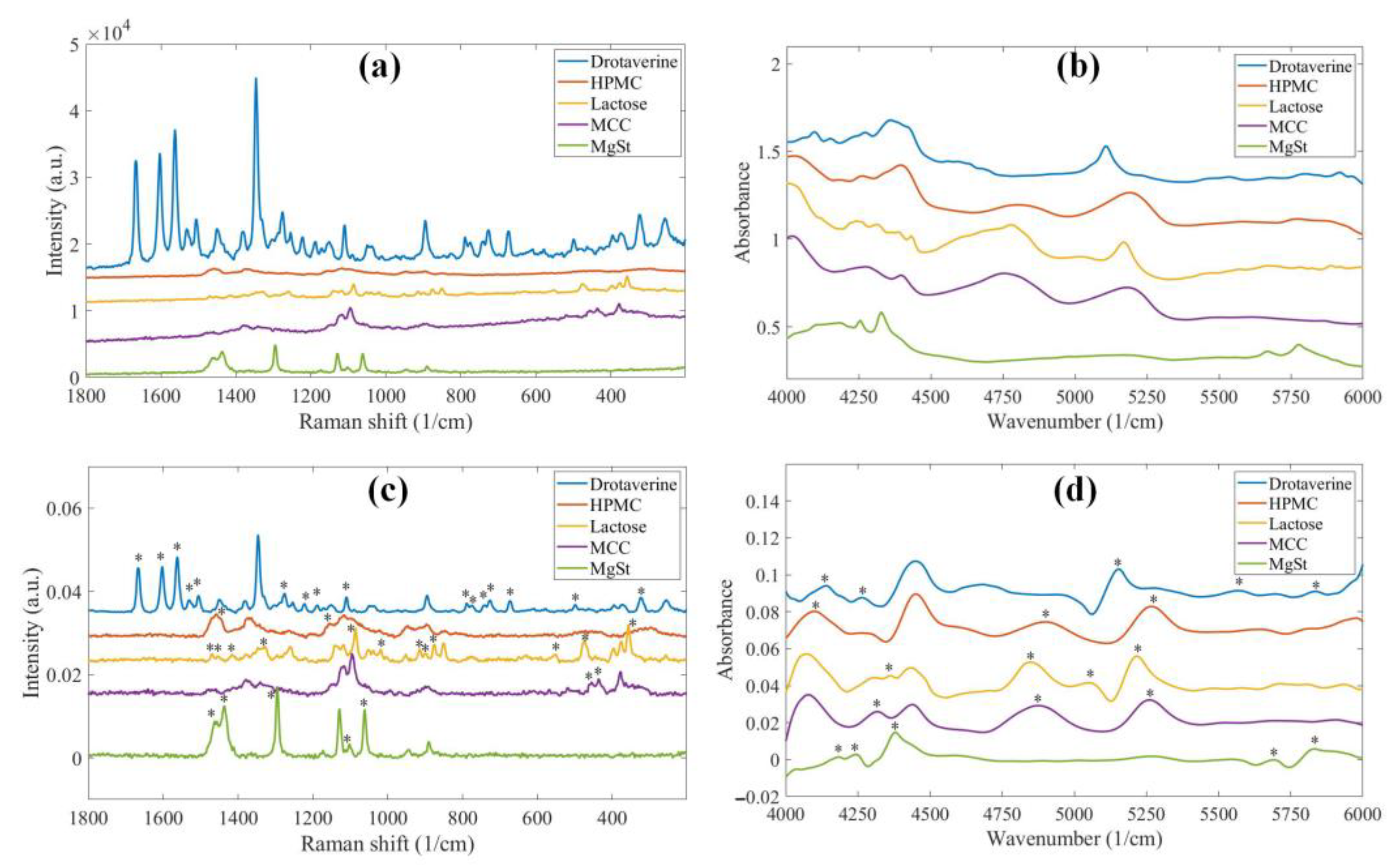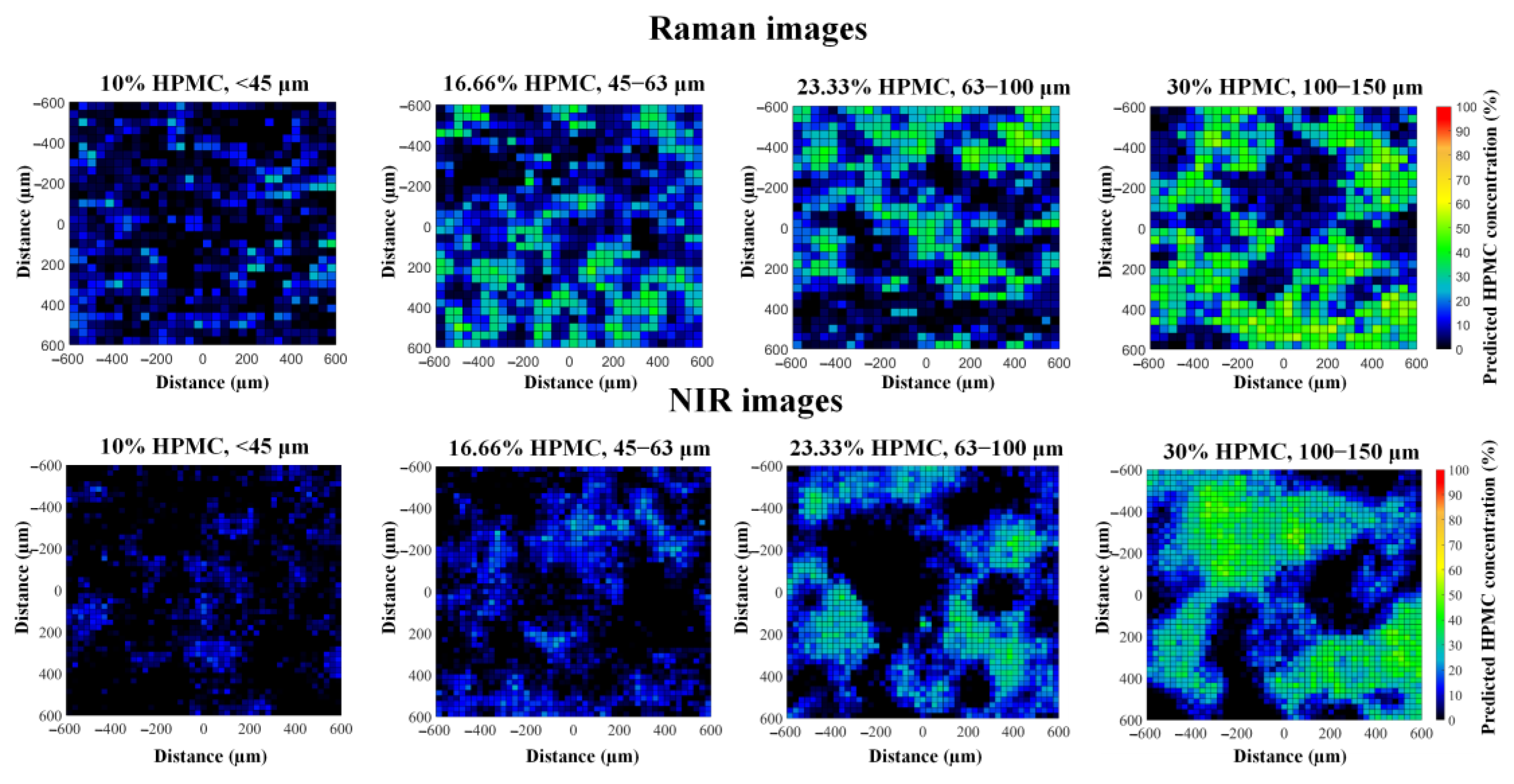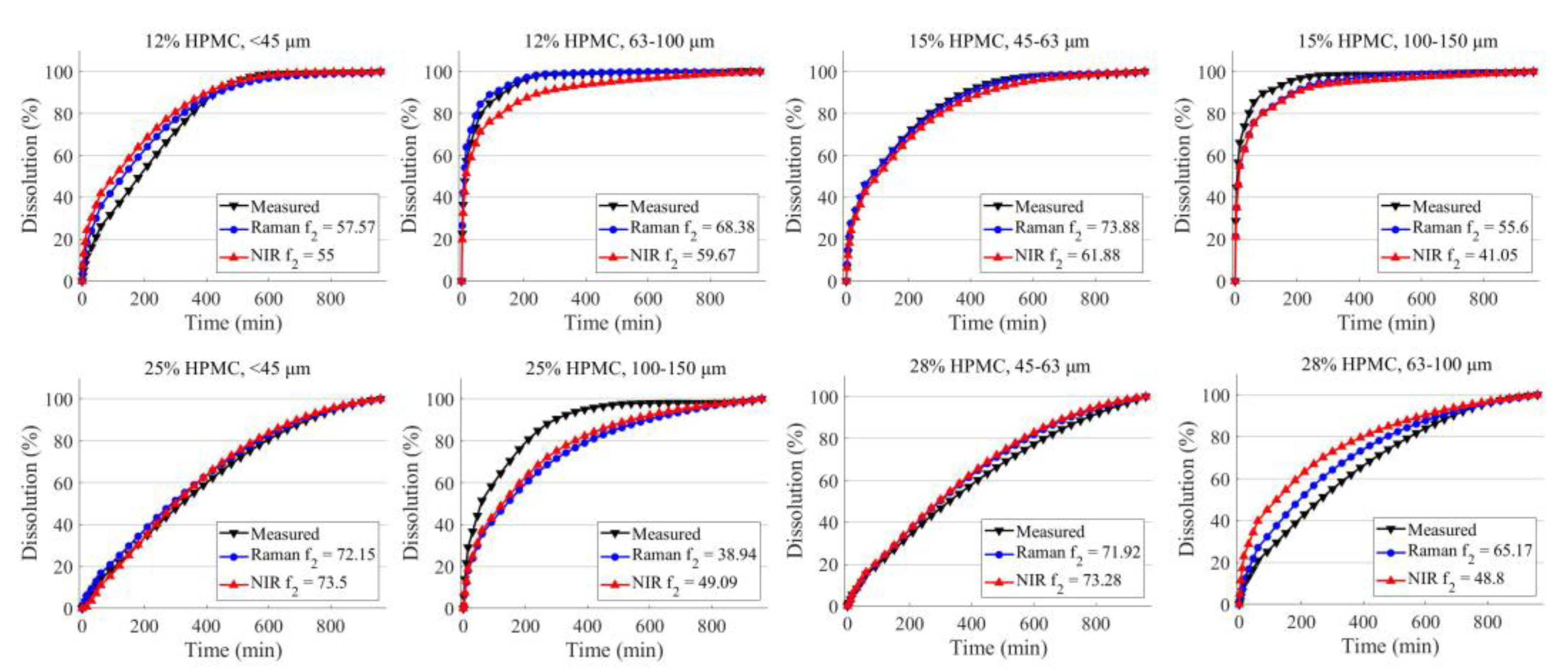Comparing the Performance of Raman and Near-Infrared Imaging in the Prediction of the In Vitro Dissolution Profile of Extended-Release Tablets Based on Artificial Neural Networks
Abstract
:1. Introduction
2. Results and Discussion
2.1. Evaluation of the Chemical Images
2.2. Prediction of the Dissolution Profiles
3. Materials and Methods
3.1. Materials
3.2. Methods
3.2.1. Sieving of Components
3.2.2. Preparation of Tablets
3.2.3. Fast Raman Imaging
3.2.4. Near-Infrared Chemical Imaging
3.2.5. In Vitro Dissolution Testing
3.3. Data Processing
3.3.1. Processing of Chemical Images
3.3.2. Creation of Model for Prediction of Dissolution Profiles
4. Conclusions
Supplementary Materials
Author Contributions
Funding
Institutional Review Board Statement
Informed Consent Statement
Data Availability Statement
Conflicts of Interest
References
- Amigo, J.M.; Babamoradi, H.; Elcoroaristizabal, S. Hyperspectral image analysis. A tutorial. Anal. Chim. Acta 2015, 896, 34–51. [Google Scholar] [CrossRef] [PubMed]
- Zeng, Q.; Wang, L.; Wu, S.; Fang, G.; Zhao, M.; Li, Z.; Li, W. Research Progress on the Application of Spectral Imaging Technology in Pharmaceutical Tablet Analysis. Int. J. Pharm. 2022, 625, 122100. [Google Scholar] [CrossRef]
- Smith, G.P.; McGoverin, C.M.; Fraser, S.J.; Gordon, K.C. Raman imaging of drug delivery systems. Adv. Drug Deliv. Rev. 2015, 89, 21–41. [Google Scholar] [CrossRef]
- Ewing, A.V.; Kazarian, S.G. Recent advances in the applications of vibrational spectroscopic imaging and mapping to pharmaceutical formulations. Spectrochim. Acta Part A Mol. Biomol. Spectrosc. 2018, 197, 10–29. [Google Scholar] [CrossRef] [PubMed]
- Wang, W.-t.; Zhang, H.; Yuan, Y.; Guo, Y.; He, S.-x. Research progress of Raman spectroscopy in drug analysis. AAPS PharmSciTech 2018, 19, 2921–2928. [Google Scholar] [CrossRef] [PubMed]
- Galata, D.L.; Zsiros, B.; Mészáros, L.A.; Nagy, B.; Szabó, E.; Farkas, A.; Nagy, Z.K. Raman mapping-based non-destructive dissolution prediction of sustained-release tablets. J. Pharm. Biomed. Anal. 2022, 212, 114661. [Google Scholar] [CrossRef]
- Hu, C.; Wang, X.; Liu, L.; Fu, C.; Chu, K.; Smith, Z.J. Fast confocal Raman imaging via context-aware compressive sensing. Analyst 2021, 146, 2348–2357. [Google Scholar] [CrossRef]
- Slipchenko, M.N.; Chen, H.; Ely, D.R.; Jung, Y.; Carvajal, M.T.; Cheng, J.-X. Vibrational imaging of tablets by epi-detected stimulated Raman scattering microscopy. Analyst 2010, 135, 2613–2619. [Google Scholar] [CrossRef]
- Nagy, B.; Farkas, A.; Borbás, E.; Vass, P.; Nagy, Z.K.; Marosi, G. Raman spectroscopy for process analytical technologies of pharmaceutical secondary manufacturing. AAPS PharmSciTech 2019, 20, 1. [Google Scholar] [CrossRef]
- Nishii, T.; Matsuzaki, K.; Morita, S. Real-time determination and visualization of two independent quantities during a manufacturing process of pharmaceutical tablets by near-infrared hyperspectral imaging combined with multivariate analysis. Int. J. Pharm. 2020, 590, 119871. [Google Scholar] [CrossRef]
- Carruthers, H.; Clark, D.; Clarke, F.C.; Faulds, K.; Graham, D. Evaluation of laser direct infrared imaging for rapid analysis of pharmaceutical tablets. Anal. Methods 2022, 14, 1862–1871. [Google Scholar] [CrossRef]
- Gendrin, C.; Roggo, Y.; Collet, C. Content uniformity of pharmaceutical solid dosage forms by near infrared hyperspectral imaging: A feasibility study. Talanta 2007, 73, 733–741. [Google Scholar] [CrossRef]
- Kandpal, L.M.; Cho, B.-K.; Tewari, J.; Gopinathan, N. Raman spectral imaging technique for API detection in pharmaceutical microtablets. Sens. Actuators B Chem. 2018, 260, 213–222. [Google Scholar] [CrossRef]
- Šašiċ, S.; Kong, A.; Kaul, G. Determining API domain sizes in pharmaceutical tablets and blends upon varying milling conditions by near-infrared chemical imaging. Anal. Methods 2013, 5, 2360–2368. [Google Scholar] [CrossRef]
- Muthudoss, P.; Kumar, S.; Ann, E.Y.C.; Young, K.J.; Chi, R.L.R.; Allada, R.; Jayagopal, B.; Dubala, A.; Babla, I.B.; Das, S.; et al. Topologically directed confocal Raman imaging (TD-CRI): Advanced Raman imaging towards compositional and micromeritic profiling of a commercial tablet components. J. Pharm. Biomed. Anal. 2022, 210, 114581. [Google Scholar] [CrossRef] [PubMed]
- Maurer, L.; Leuenberger, H. Terahertz pulsed imaging and near infrared imaging to monitor the coating process of pharmaceutical tablets. Int. J. Pharm. 2009, 370, 8–16. [Google Scholar] [CrossRef]
- Song, S.W.; Kim, J.; Eum, C.; Cho, Y.; Park, C.R.; Woo, Y.-A.; Kim, H.M.; Chung, H. Hyperspectral Raman line mapping as an effective tool to monitor the coating thickness of pharmaceutical tablets. Anal. Chem. 2019, 91, 5810–5816. [Google Scholar] [CrossRef] [PubMed]
- Da Silva, V.H.; Soares-Sobrinho, J.L.; Pereira, C.F.; Rinnan, Å. Evaluation of chemometric approaches for polymorphs quantification in tablets using near-infrared hyperspectral images. Eur. J. Pharm. Biopharm. 2019, 134, 20–28. [Google Scholar] [CrossRef]
- Sarri, B.; Canonge, R.; Audier, X.; Lavastre, V.; Pénarier, G.; Alie, J.; Rigneault, H. Discriminating polymorph distributions in pharmaceutical tablets using stimulated Raman scattering microscopy. J. Raman Spectrosc. 2019, 50, 1896–1904. [Google Scholar] [CrossRef]
- Alexandrino, G.L.; Khorasani, M.R.; Amigo, J.M.; Rantanen, J.; Poppi, R.J. Monitoring of multiple solid-state transformations at tablet surfaces using multi-series near-infrared hyperspectral imaging and multivariate curve resolution. Eur. J. Pharm. Biopharm. 2015, 93, 224–230. [Google Scholar] [CrossRef]
- Fateixa, S.; Mulandeza, O.; Nogueira, H.I.; Trindade, T. Raman imaging studies on the stability of Paracetamol tablets under different storage conditions. Vib. Spectrosc. 2023, 124, 103488. [Google Scholar] [CrossRef]
- Sabin, G.P.; Lozano, V.A.; Rocha, W.F.; Romão, W.; Ortiz, R.S.; Poppi, R.J. Characterization of sildenafil citrate tablets of different sources by near infrared chemical imaging and chemometric tools. J. Pharm. Biomed. Anal. 2013, 85, 207–212. [Google Scholar] [CrossRef] [PubMed]
- Rebiere, H.; Martin, M.; Ghyselinck, C.; Bonnet, P.-A.; Brenier, C. Raman chemical imaging for spectroscopic screening and direct quantification of falsified drugs. J. Pharm. Biomed. Anal. 2018, 148, 316–323. [Google Scholar] [CrossRef] [PubMed]
- Mitsutake, H.; Neves, M.D.G.; Rutledge, D.N.; Poppi, R.J.; Breitkreitz, M.C. Extraction of information about structural changes in a semisolid pharmaceutical formulation from near-infrared and Raman images by multivariate curve resolution–alternating least squares and ComDim. J. Chemom. 2020, 34, e3288. [Google Scholar] [CrossRef]
- Yekpe, K.; Abatzoglou, N.; Bataille, B.; Gosselin, R.; Sharkawi, T.; Simard, J.-S.; Cournoyer, A. Predicting the dissolution behavior of pharmaceutical tablets with NIR chemical imaging. Int. J. Pharm. 2015, 486, 242–251. [Google Scholar] [CrossRef]
- Galata, D.L.; Zsiros, B.; Knyihár, G.; Péterfi, O.; Mészáros, L.A.; Ronkay, F.; Nagy, B.; Szabó, E.; Nagy, Z.K.; Farkas, A. Convolutional neural network-based evaluation of chemical maps obtained by fast Raman imaging for prediction of tablet dissolution profiles. Int. J. Pharm. 2023, 640, 123001. [Google Scholar] [CrossRef]
- Šašić, S. An in-depth analysis of Raman and near-infrared chemical images of common pharmaceutical tablets. Appl. Spectrosc. 2007, 61, 239–250. [Google Scholar] [CrossRef]
- Šašić, S. Parallel imaging of active pharmaceutical ingredients in some tablets and blends on Raman and near-infrared mapping and imaging platforms. Anal. Methods 2011, 3, 806–813. [Google Scholar] [CrossRef]
- Šašić, S. Chemical imaging of pharmaceutical granules by Raman global illumination and near-infrared mapping platforms. Anal. Chim. Acta 2008, 611, 73–79. [Google Scholar] [CrossRef]
- Carruthers, H.; Clark, D.; Clarke, F.; Faulds, K.; Graham, D. Comparison of Raman and near-infrared chemical mapping for the analysis of pharmaceutical tablets. Appl. Spectrosc. 2021, 75, 178–188. [Google Scholar] [CrossRef]
- Lopes, M.B.; Bioucas-Dias, J.M.; Figueiredo, M.A.; Wolff, J.-C.; Mistry, N.; Warrack, J. Comparison of near infrared and raman hyperspectral unmixing performances for chemical identification of pharmaceutical tablets. In Proceedings of the 2011 3rd Workshop on Hyperspectral Image and Signal Processing: Evolution in Remote Sensing (WHISPERS), Lisbon, Portugal, 6–9 June 2011; pp. 1–4. [Google Scholar]
- Tu, L.; Liao, Z.; Luo, Z.; Wu, Y.L.; Herrmann, A.; Huo, S. Ultrasound-controlled drug release and drug activation for cancer therapy. In Proceedings of the Exploration, Perth, Australia, 22–25 October 2021; p. 20210023. [Google Scholar]
- Gong, D.; Celi, N.; Zhang, D.; Cai, J. Magnetic biohybrid microrobot multimers based on chlorella cells for enhanced targeted drug delivery. ACS Appl. Mater. Interfaces 2022, 14, 6320–6330. [Google Scholar] [CrossRef] [PubMed]
- Maderuelo, C.; Zarzuelo, A.; Lanao, J.M. Critical factors in the release of drugs from sustained release hydrophilic matrices. J. Control. Release 2011, 154, 2–19. [Google Scholar] [CrossRef] [PubMed]
- Nagy, B.; Galata, D.L.; Farkas, A.; Nagy, Z.K. Application of Artificial Neural Networks in the Process Analytical Technology of Pharmaceutical Manufacturing—A Review. AAPS J. 2022, 24, 74. [Google Scholar] [CrossRef] [PubMed]
- Nagy, B.; Szabados-Nacsa, Á.; Fülöp, G.; Nagyné, A.T.; Galata, D.L.; Farkas, A.; Mészáros, L.A.; Nagy, Z.K.; Marosi, G. Interpretable artificial neural networks for retrospective QbD of pharmaceutical tablet manufacturing based on a pilot-scale developmental dataset. Int. J. Pharm. 2023, 633, 122620. [Google Scholar] [CrossRef]
- Salahuddin, Z.; Woodruff, H.C.; Chatterjee, A.; Lambin, P. Transparency of deep neural networks for medical image analysis: A review of interpretability methods. Comput. Biol. Med. 2022, 140, 105111. [Google Scholar] [CrossRef]





| Name of Formulation | DR Concentration (w/w%) | HPMC Concentration (w/w%) | MCC Concentration (w/w%) | Lactose Concentration (w/w%) | MgSt Concentration (w/w%) | HPMC Size Fraction |
|---|---|---|---|---|---|---|
| Tablets used for calibration | ||||||
| DR01 | 8 | 10 | 20 | 60 | 2 | <45 µm |
| DR02 | 8 | 10 | 20 | 60 | 2 | 45–63 µm |
| DR03 | 8 | 10 | 20 | 60 | 2 | 63–100 µm |
| DR04 | 8 | 10 | 20 | 60 | 2 | 100–150 µm |
| DR05 | 8 | 13.33 | 20 | 56.67 | 2 | <45 µm |
| DR06 | 8 | 13.33 | 20 | 56.67 | 2 | 45–63 µm |
| DR07 | 8 | 13.33 | 20 | 56.67 | 2 | 63–100 µm |
| DR08 | 8 | 13.33 | 20 | 56.67 | 2 | 100–150 µm |
| DR09 | 8 | 16.66 | 20 | 53.34 | 2 | <45 µm |
| DR10 | 8 | 16.66 | 20 | 53.34 | 2 | 45–63 µm |
| DR11 | 8 | 16.66 | 20 | 53.34 | 2 | 63–100 µm |
| DR12 | 8 | 16.66 | 20 | 53.34 | 2 | 100–150 µm |
| DR13 | 8 | 20 | 20 | 50 | 2 | <45 µm |
| DR14 | 8 | 20 | 20 | 50 | 2 | 45–63 µm |
| DR15 | 8 | 20 | 20 | 50 | 2 | 63–100 µm |
| DR16 | 8 | 20 | 20 | 50 | 2 | 100–150 µm |
| DR17 | 8 | 23.33 | 20 | 46.67 | 2 | <45 µm |
| DR18 | 8 | 23.33 | 20 | 46.67 | 2 | 45–63 µm |
| DR19 | 8 | 23.33 | 20 | 46.67 | 2 | 63–100 µm |
| DR20 | 8 | 23.33 | 20 | 46.67 | 2 | 100–150 µm |
| DR21 | 8 | 26.66 | 20 | 43.34 | 2 | <45 µm |
| DR22 | 8 | 26.66 | 20 | 43.34 | 2 | 45–63 µm |
| DR23 | 8 | 26.66 | 20 | 43.34 | 2 | 63–100 µm |
| DR24 | 8 | 26.66 | 20 | 43.34 | 2 | 100–150 µm |
| DR25 | 8 | 30 | 20 | 40 | 2 | <45 µm |
| DR26 | 8 | 30 | 20 | 40 | 2 | 45–63 µm |
| DR27 | 8 | 30 | 20 | 40 | 2 | 63–100 µm |
| DR28 | 8 | 30 | 20 | 40 | 2 | 100–150 µm |
| Tablets used for validation | ||||||
| DRV01 | 8 | 12 | 20 | 58 | 2 | <45 µm |
| DRV02 | 8 | 12 | 20 | 58 | 2 | 63–100 µm |
| DRV03 | 8 | 15 | 20 | 55 | 2 | 45–63 µm |
| DRV04 | 8 | 15 | 20 | 55 | 2 | 100–150 µm |
| DRV05 | 8 | 25 | 20 | 45 | 2 | <45 µm |
| DRV06 | 8 | 25 | 20 | 45 | 2 | 100–150 µm |
| DRV07 | 8 | 28 | 20 | 42 | 2 | 45–63 µm |
| DRV08 | 8 | 28 | 20 | 42 | 2 | 63–100 µm |
| Property | Value |
|---|---|
| Weight | 503.8 ± 2.8 mg |
| Height | 3.77 ± 0.07 mm |
| Crushing strength | 98.3 ± 9.3 N |
| Friability | 0.79% |
| Raman Imaging | NIR Imaging | |
|---|---|---|
| Mapped area size | 1200 × 1200 µm2 | 1200 × 1200 µm2 |
| Step size | 40 µm | 25 µm |
| Number of points | 31 × 31 | 48 × 48 |
| Spectrum measurement time | 0.1 s | 0.014 s |
| Number of scans | 3 | 2 |
| Map measurement time | 5.8 min | 1.1 min |
Disclaimer/Publisher’s Note: The statements, opinions and data contained in all publications are solely those of the individual author(s) and contributor(s) and not of MDPI and/or the editor(s). MDPI and/or the editor(s) disclaim responsibility for any injury to people or property resulting from any ideas, methods, instructions or products referred to in the content. |
© 2023 by the authors. Licensee MDPI, Basel, Switzerland. This article is an open access article distributed under the terms and conditions of the Creative Commons Attribution (CC BY) license (https://creativecommons.org/licenses/by/4.0/).
Share and Cite
Galata, D.L.; Gergely, S.; Nagy, R.; Slezsák, J.; Ronkay, F.; Nagy, Z.K.; Farkas, A. Comparing the Performance of Raman and Near-Infrared Imaging in the Prediction of the In Vitro Dissolution Profile of Extended-Release Tablets Based on Artificial Neural Networks. Pharmaceuticals 2023, 16, 1243. https://doi.org/10.3390/ph16091243
Galata DL, Gergely S, Nagy R, Slezsák J, Ronkay F, Nagy ZK, Farkas A. Comparing the Performance of Raman and Near-Infrared Imaging in the Prediction of the In Vitro Dissolution Profile of Extended-Release Tablets Based on Artificial Neural Networks. Pharmaceuticals. 2023; 16(9):1243. https://doi.org/10.3390/ph16091243
Chicago/Turabian StyleGalata, Dorián László, Szilveszter Gergely, Rebeka Nagy, János Slezsák, Ferenc Ronkay, Zsombor Kristóf Nagy, and Attila Farkas. 2023. "Comparing the Performance of Raman and Near-Infrared Imaging in the Prediction of the In Vitro Dissolution Profile of Extended-Release Tablets Based on Artificial Neural Networks" Pharmaceuticals 16, no. 9: 1243. https://doi.org/10.3390/ph16091243
APA StyleGalata, D. L., Gergely, S., Nagy, R., Slezsák, J., Ronkay, F., Nagy, Z. K., & Farkas, A. (2023). Comparing the Performance of Raman and Near-Infrared Imaging in the Prediction of the In Vitro Dissolution Profile of Extended-Release Tablets Based on Artificial Neural Networks. Pharmaceuticals, 16(9), 1243. https://doi.org/10.3390/ph16091243






